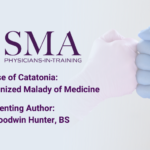Abstract | May 4, 2021
A Case of Catatonia – an Under-recognized Malady of Medicine
Learning Objectives
- Recognize the gap in identification of catatonia as a medical diagnosis;
- Enhance understanding of catatonia, its treatment, and how increased recognition will improve healthcare.
Introduction:
Catatonia is found to be present in 7.6% – 38% of psychiatric patients presenting to US hospitals. Catatonia is a behavioral syndrome characterized by dyskinesia, most commonly found in the context of underlying organic or psychiatric diseases. The presentation often goes unrecognized and misdiagnosed. Better recognition of catatonia will decrease hospital admission and improve overall patient outcomes. We present a rare case of catatonia in a 51-year-old Caucasian male with acute changes in neurological baseline.
Case Presentation:
A 51-year-old male presented to the ED with his spouse due to lethargy and strange behavior. Per the family, the patient was experiencing psychosocial stressors which had exacerbated his underlying depression. Four days prior, the patient became unresponsive and began having difficulties with ADLs. The wife reported an intermittent tremor present in all extremities. The patient’s medical history included diabetes, hypertension, depression, anxiety and hyperlipidemia, with no recent changes in medication. One year prior, the patient had a MVC and received pelvic ring fixation. He denied alcohol or tobacco use, but confirmed use of marijuana and alprazolam. On admission, the patient was unresponsive and staring vacantly. The patient was hypertensive and routine chemistry was found to be WNL. On examination, the patient appeared nutritionally well, in no acute distress but was disheveled and immobile. He had flat affect, upper extremity rigidity, and bilateral eyelid twitching. He was able to follow the command of squeezing fingers. The remaining exam was normal. Patient evaluation excluded metabolic or infectious etiologies. Head CT was unremarkable. Neurology consult determined the patient’s disposition was unlikely neurological in nature. EKG showed sinus tachycardia, an old infarct, and left atrial enlargement. Psychiatry was consulted and suggested catatonia as the possible etiology. Patient was given a lorazepam trial.
Final Diagnosis:
Catatonia
Outcome:
After 5 hours of lorazepam, the patient was more alert, oriented, and responsive. The following day, he was effectively communicating, ambulating with assistance, and reported feeling more in control of himself. On day 3 of lorazepam, the patient returned to baseline and was discharged home with his wife to begin treatment of his underlying psychiatric condition.

